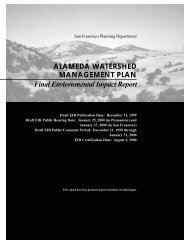Feasibility of Fish Passage at Alameda Creek Diversion Dam
Feasibility of Fish Passage at Alameda Creek Diversion Dam
Feasibility of Fish Passage at Alameda Creek Diversion Dam
Create successful ePaper yourself
Turn your PDF publications into a flip-book with our unique Google optimized e-Paper software.
<strong>Feasibility</strong> <strong>of</strong> <strong>Fish</strong> <strong>Passage</strong> <strong>at</strong> <strong>Alameda</strong> <strong>Creek</strong> <strong>Diversion</strong> <strong>Dam</strong>For the cost <strong>of</strong> w<strong>at</strong>er associ<strong>at</strong>ed with oper<strong>at</strong>ing the fish ladder design component, the estim<strong>at</strong>ed annualw<strong>at</strong>er cost assumes th<strong>at</strong> the SFPUC-proposed normal w<strong>at</strong>er year instream flows will be used when theyare available <strong>at</strong> ACDD during the adult immigr<strong>at</strong>ion period <strong>of</strong> December through April. Assuming th<strong>at</strong> aflow <strong>of</strong> 10 cfs is sufficient to oper<strong>at</strong>e the fish ladder, 12 opportunity costs would not be incurred when theSFPUC-proposed normal w<strong>at</strong>er year instream flows are bypassed between approxim<strong>at</strong>ely January 11 andApril 30. During this time period, the fish ladder flow (10 cfs) combined with the fish screen bypass flows(5 cfs) would be less than the SFPUC-proposed normal w<strong>at</strong>er year instream flows (Table 2-3). The w<strong>at</strong>erth<strong>at</strong> would be bypassed <strong>at</strong> ACDD and assumed to be available for oper<strong>at</strong>ion <strong>of</strong> screens and ladders withoutincurring additional cost, is shown in green on Figure 5-3.However, from December 1 to approxim<strong>at</strong>ely January 11, the SFPUC-proposed normal w<strong>at</strong>er yearinstream flows, along with WSIP Final PEIR mitig<strong>at</strong>ion flows <strong>of</strong> 10 cfs, are estim<strong>at</strong>ed to be insufficient tooper<strong>at</strong>e both a fish ladder and fish screen bypass. In th<strong>at</strong> case, the w<strong>at</strong>er cost estim<strong>at</strong>ed for oper<strong>at</strong>ion <strong>of</strong>screens and ladders includes the cost <strong>of</strong> these additional flows (shown in pink in Figure 5-3). The cost <strong>of</strong>the additional flows <strong>of</strong> up to 5 cfs th<strong>at</strong> would be required from December 1 through approxim<strong>at</strong>elyJanuary 11, when sufficient flows are available, are applied to the annual cost <strong>of</strong> oper<strong>at</strong>ing a fish ladder.Similar to the analysis <strong>of</strong> reduction in diversion capacity due to screening described in Section 5.2.1,predicted daily average flows from the model described in Appendix B were used to estim<strong>at</strong>eunimpaired flow for each day in the simul<strong>at</strong>ed period. These unimpaired flows were then used tocalcul<strong>at</strong>e the daily difference between SFPUC-proposed normal w<strong>at</strong>er year instream flows and flowsrequired for oper<strong>at</strong>ion <strong>of</strong> a fish screen bypass and fish ladder combined, for the period fromDecember 1 through approxim<strong>at</strong>ely January 11 when the proposed flows would not be sufficient foroper<strong>at</strong>ing these two design components. Based on this analysis, the additional volume <strong>of</strong> w<strong>at</strong>errequired to oper<strong>at</strong>e a fish ladder <strong>at</strong> ACDD (potentially required from December 1 throughapproxim<strong>at</strong>ely January 11, only when sufficient flows are available) during the simul<strong>at</strong>ed period <strong>of</strong>record (1969-1985 and 1996-2004) would range annually from 0 to 440 acre-feet. The estim<strong>at</strong>edvolume <strong>of</strong> w<strong>at</strong>er th<strong>at</strong> would be required to oper<strong>at</strong>e a fish ladder is illustr<strong>at</strong>ed in Figure 5-3 for both awet year and a dry year. The average annual volume <strong>of</strong> w<strong>at</strong>er required to oper<strong>at</strong>e a fish ladder, inexcess <strong>of</strong> the SFPUC-proposed normal w<strong>at</strong>er year instream flows, is approxim<strong>at</strong>ely 130 acre-feet.Based on the estim<strong>at</strong>ed 2016 w<strong>at</strong>er r<strong>at</strong>e <strong>of</strong> $1,500 per acre-foot, the average annual lost diversionopportunity cost associ<strong>at</strong>ed with oper<strong>at</strong>ion <strong>of</strong> a fish ladder to facilit<strong>at</strong>e steelhead immigr<strong>at</strong>ion isapproxim<strong>at</strong>ely $195,000. This w<strong>at</strong>er cost is added to the annualized fish ladder cost in Section 5.3.5.2.4 LIMITATIONS OF WATER DIVERSION ESTIMATIONSA number <strong>of</strong> limit<strong>at</strong>ions are associ<strong>at</strong>ed with the lost w<strong>at</strong>er diversion opportunity costs for both screensand fishways, some <strong>of</strong> which may affect the accuracy <strong>of</strong> the estim<strong>at</strong>es. Limit<strong>at</strong>ions with this analysisare listed below:■Daily averages were used to model flows in <strong>Alameda</strong> <strong>Creek</strong> because those d<strong>at</strong>a were available,but daily average flow does not accur<strong>at</strong>ely represent the flashy n<strong>at</strong>ure <strong>of</strong> flows in <strong>Alameda</strong> <strong>Creek</strong>.Because the daily average reduces the height <strong>of</strong> the short peaks th<strong>at</strong> occur in the hydrographimmedi<strong>at</strong>ely after precipit<strong>at</strong>ion events, use <strong>of</strong> these d<strong>at</strong>a underestim<strong>at</strong>es the quantity <strong>of</strong> w<strong>at</strong>er inexcess <strong>of</strong> the diversion capacity <strong>of</strong> the ACDT th<strong>at</strong> flows down <strong>Alameda</strong> <strong>Creek</strong> and over theACDD. Use <strong>of</strong> shorter time-step d<strong>at</strong>a, such as 15-minute interval real-time flow d<strong>at</strong>a, would12 This estim<strong>at</strong>e is based on a preliminary review <strong>of</strong> the <strong>Alameda</strong> <strong>Creek</strong> hydrograph and the Long <strong>Fish</strong>way described inSection 4.1. A more accur<strong>at</strong>e estim<strong>at</strong>e <strong>of</strong> flows through a fishway <strong>at</strong> ACDD would require a flow dur<strong>at</strong>ion analysis, astorm peaking analysis, design work, and a stage discharge evalu<strong>at</strong>ion.ACDD <strong>Passage</strong> June 2009 Page 5-8








